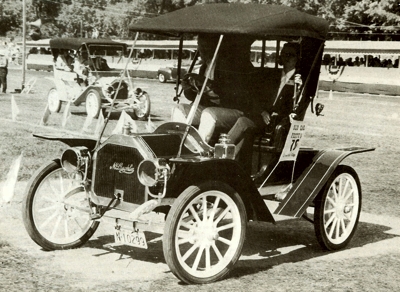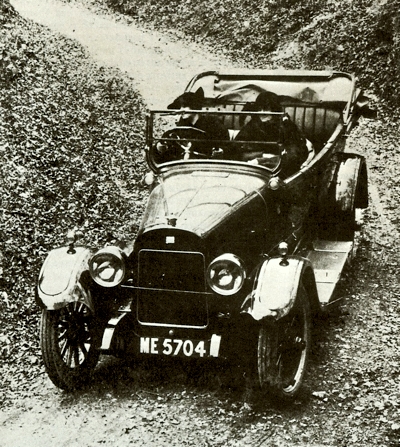'AUTOMOBILE MANUFACTURING in Canada has not attained any volume at present', wrote an English journalist in 1904, 'although several enterprises are likely to take up the industry'.
Among the likeliest candidates was the McLaughlin Carriage Company of Oshawa, Ontario, founded in 1867, the same year that the Dominion of Canada had come into being, and 40 years later one of the country's most highly regarded carriage builders.
By 1900, however, the carriage trade was in a bad way, with too many companies fighting for the available business. Diversification seemed inevitable, but on the face of it Canada was a distinctly unpromising market for motor cars, as at the end of 1903 there were not more than 220 cars in the 12 provinces and 8,500,000 square miles of the Dominion.
The Leroy, Queen, Moss and Still
Also, the indigenous designs that had already been produced in Canada had proved far from successful. There had been the Leroy, built in Berlin, Ontario (renamed Kitchener during World War 1), which had only two speeds-forwards and backwards - yet survived for three years and over 30 cars, and the Queen, from Toronto (notable only for its excessively poor performance), the Moss and the Still.
All had failed miserably. Yet the alternative - importing a proven design from America - was expensive, as there was a 35 per cent tariff levied on the wholesale price, so that a Ford, which sold in Detroit for $800, cost $1000 in Toronto. It was more economical for Canadian companies with sufficient facilities to build cars to American designs, making as much as possible themselves, and importing the remaining components, which attracted a far lower rate of duty than complete vehicles.
This scheme could be made profitable, as proven by Henry Ford, who reorganised the long-established Walkerville Wagon Company in Ontario in 1904 as the Ford Motor Company of Canada, and it was doubtless why, a few years later, Billy Durant of General Motors began casting around for a foothold in Canada.
Durant and McLaughlin's 15 year Agreement
Coincidentally, Robert McLaughlin and his sons were planning to start production of cars of all-Canadian content, a plan which was rendered stillborn when their chief engineer fell ill. Durant and McLaughlin met, and agreed to co-operate. McLaughlin contracted, on very advantageous terms, to use Buick engines and components, while constructing his own coachwork. The agreement was for 15 years.
 1909 McLaughlin Tourer, made from parts from a comtemporary Buick.
1909 McLaughlin Tourer, made from parts from a comtemporary Buick.
 1922 McLaughlin Buick. In 1923, the name was changed officially.
1922 McLaughlin Buick. In 1923, the name was changed officially. |
The first McLaughlin appeared in 1908, and upwards of 200 cars were produced in the next 12 months, based on the contemporary four-cylinder Buick; sales more than doubled during the following year. Mcl.aughlin production was minute compared to Buick output, but this also meant that, especially in the era of the coachbuilt wooden body, each McLaughlin was that much better finished and luxurious than its contemporary.
Alfred P. Sloan
Nevertheless, the Canadian company did change its name to Buick, only to be met by such a drop in sales that the title was hurriedly changed back again. It was well after that time that Alfred P. Sloan, who took over control of General Motors from Durant in 1920 saw a McLaughlin parked outside the New York Buick Showrooms and angrily demanded its removal in case a prospective Buick customer should see it and want his car to be as well finished and equipped.
Until 1922, when the original contract ran out, McLaughlin production was based on contemporary General Motors chassis (the Bui.ck four and six-cylinder and the Oakland light six). From 1915, there had been a Chevrolet-based McLaughlin as well, and the link between McLaughlin and GM became absolute in 1918 when the company became a wholly owned subsidiary of the Detroit company and was renamed General Motors of Canada.
McLaughlin-Buicks and Empire Preference
In 1923, the cars were renamed, too, becoming McLaughlin-Buicks; they were, however, imported into Britain as plain Buicks, a venture which enabled their price to be substantially lower than had they been imported from Michigan, thanks to Empire preference, Canadian-built cars paid a duty of 22 2/9ths per cent compared with 33½ per cent levied on US-made cars.
McLaughlin Empress, Majestic, Monarch and Piccadilly
Consequently, the British-marketed models tended to carry names such as Empress, Majestic, Monarch and Piccadilly to emphasise their Imperial origins, although underneath it all they were more and more akin to the Detroit-built article. It was a Canadian Buick which took Mrs Simpson into exile after Edward VIII had abdicated; three years later, two McLaughlin-Buick limousines were built for the Royal Visit of George VI and Queen Elizabeth to Canada. However, by this time McLaughlin had lost most of its original individuality, and in 1942 the McLaughlin part of the name was dropped for good.
